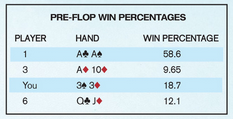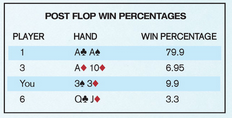GAME SAVVY: THE TERRIBLE THREES
Just reading about poker strategy will get you only so far. Test your poker skills and compare your choices to the odds in this interactive article.
Playing No limit Texas Hold ‘em is an art form. Knowing which cards to play, how much to bet and what to do to either keep an opponent involved or drive him out of the hand is tricky business. Many times, the decision is made for you. The hand is so powerful or has so much potential that you’d be a fool not to play it. Other times, it’s so rotten that unless you’re planning to bluff your way to victory, it’s best to just walk away.
And then there are the gray areas – the hands that are circumstantial and can go either way. With these types of hands there are more factors to consider, factors that can change abruptly as everything unfolds. Position, types of opponents, structure, chip stack and the like all need to be considered as you weigh the viability of the hand. And that’s where the game can get rough.
With that in mind, we’ve concocted a simple little test to help gauge your Hold ‘em abilities. Read the scenario, circle your answers, and compare how well you played to our experts. A full analysis of the hand can be found at the end of the article (no peeking!) If at any point you fold the hand or go all-in, jump to the appropriate section and see how favorable (or unfavorable) the play was at that stage of the hand.
Ready to play? Then grab your pencils and get set to see just how far your abilities will take you in this game.
THE SCENARIO
You’re playing an online No Limit Hold ’em satellite, vying against 900 others for a seat in a major poker tournament For the past few hours you’ve managed to maintain a constant— though less-than spectacular—chip count, your stack growing in proportion to the cost of the blinds. You’re currently seated at a 10-person table populated by a mix of conservative and aggressive players whose stacks range anywhere from 2,000 chips to 30,000. You currently have an average stack of 8,000 chips and the blinds have just reached 200/400.
PRE-FLOP
You begin this hand with pocket threes and your position has you as the fourth to act.
Starting things off is Player 1, who has so far been very aggressive (and at times a bit erratically) who bets 800 chips. Player 2 folds but Player 3 quickly calls. It’s now your turn to act. Should you:
- A) Fold
- B) Call
- C) Re-raise to 1,200
Following your decision, the rest of the table folds with the exception of Player 6 who quietly calls. Assuming that you have decided to enter the hand, there are a total of four players invested in the pot and the current field for this hand is as follows:
Player 1 ………………………………..30,000 chips
Player 3 ………………………………..18,400 chips
YOU …………………………………….8,000 chips
Player 6 ………………………………..7,500 chips
The flop hits the board:

Once the cards come out, Player 1 checks and Player 3 bets 1,000. The action is now to you. Do you:
- A) Fold
- B) Call 1,000
- C) Raise to 2,000
- D) Go All in
Following your action, Player 6 folds and Player 1 calls. The Turn comes:

With the turn, Player 1 checks allowing Player 3 the opportunity to bet yet again—which he does quickly to the tune of 3,000 chips. Do you:
- A) Fold
- B) Call
- C) Raise
Player 1 pauses for a moment and re-raises to 6,500. Player 3 calls. The action is now back to you. Calling at this point could potentially end your tournament. Do you:
- A) Fold
- B) Call/All-in
The River comes:

Since your last action resulted in your being either out or all in, there is no additional action taken on your part following the river. Now let’s move to the analysis section to see if your tournament hopes are still alive in this satellite.
STEP-BY-STEP HAND ANALYSIS
Now that you’ve made your decisions and played the hand exactly as you would in an actual online poker room, let’s see if you would have made the right or wrong choices.
PRE-FLOP
You were dealt pocket threes in middle position. Given that the betting so far this hand has been pretty tame from players ahead of you, there are two factors to consider: That either Player 1 or Player 3 is sitting on a monster and your low pair is dominated and the size of their chip stacks relative to your own.
Given these, it’s probably a pretty good idea to let this hand go now! The only thing in your favor at all at this stage is the less-than normal amount of Player 1’s wager—merely double the blind. But is he just slow playing to build up the pot? Probably, especially when you take into account his previous aggressive nature. Player 1 wants you in the pot, and it’s likely that your pocket threes don’t have what it takes to win. Add to that the fact that Player 3 quickly called, meaning he’s got something that’s worthy a flop and maybe more, the best choice at this point in your tournament is to fold.
Answer: A

THE FLOP
With that check Player 1 is either nervous that an opponent was sitting with the flush, or was confident enough in his hand to try to entice one of the remaining players into putting more money in the pot. Player 3 has aggressively obliged, but the relatively small bet signals that he’s either on a draw or paired something on the board.
For your part the flop has given your hand some flush potential, and had you stayed in you would have been praying for a spade—not knowing that if a spade were to hit you’d be in big trouble.
Answer: A

THE TURN
For those of you who continued player this hand—hoping for either another 3 to make your set or a fourth spade to hit the board—the turn actually gave you even more outs: an open-ended straight draw. The 3,000-chip bet by Player 3 at this point, however, is too prohibitive given your chip stack and only a pair of threes to speak of. And if you did call or raise, you would have been in for a rude awakening shortly after, as Player 1 finally made his move and re-raised.
Answer: A

THE RIVER
To those of you who had the guts to stay in for this long, you’re in for heartache. You actually made a flush when the seven showed on the river, but unfortunately it also yielded the nut flush for Player 1.
The final result is:

FINAL ANALYSIS
Playing low pockets pairs can be tricky business, especially if it seems to improve as the hand progresses. In short, while low pairs can be worthwhile at times and may be worth limping in or for a semi-bluff, the fact is they are dominated all-too-often. If you’re going to play them, do so only under the right circumstances and always proceed with caution.


